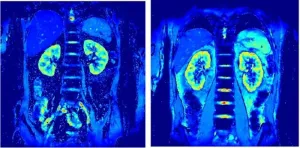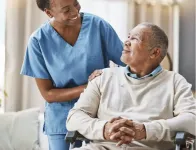(Press-News.org) When pain signals are passed along the nervous system, proteins called calcium channels play a key role. Researchers at Linköping University, Sweden, have now pinpointed the exact location of a specific calcium channel fine-tuning the strength of pain signals. This knowledge can be used to develop drugs for chronic pain that are more effective and have fewer side effects.
Pain sensations and other information are mainly conducted through our nervous system as electrical signals. Yet at decisive moments, this information is converted to biochemical signals, in the form of specific molecules. To develop future drugs against pain, researchers must understand the details of what happens at the molecular level when pain signals are converted from one form to another.
When the electrical signal reaches the end of one nerve cell it is converted into a biochemical signal, in the form of calcium. In turn, an increase in calcium triggers the release of signalling molecules called neurotransmitters. This biochemical signal is received by the next nerve cell, that converts the signal back into electricity. Along this chain of information transfer in the nervous system, one class of proteins is of particular interest: the voltage-sensitive calcium channels. These channels are like molecular machines that sense electrical signals and then open to allow calcium to flow into the nerve cell.
In the current study, researchers at Linköping University have focused on a specific type of calcium channel called CaV2.2, that is involved in the transmission of pain signals. In fact, these channels are more active during chronic pain. They are specifically located in the ends of sensory nerve cells.
Drugs that dampen their activity reduce the communication of pain signals from the sensory nerve cells to the brain. Such drugs exist, but there is a catch: a drug that blocks CaV2.2 completely has such severe side-effects that it needs to be given directly into the spinal fluid. Drugs that decrease the number of CaV2.2, like gabapentin, do not reduce chronic pain very efficiently. Another class of drugs that exploit a natural mechanism to decrease the ability of CaV2.2 to respond to pain signalling are the opioid drugs, like morphine and heroin. While very effective at blocking pain, they are also addictive and can cause devastating dependency.
“Calcium channels are very attractive drugs targets for pain treatment, but today’s solutions are inadequate,” says Antonios Pantazis, associate professor at the Department of Biomedical and Clinical Sciences at Linköping University, who has led the study published in the journal Science Advances.
The researchers studied the mechanism by which opioids decrease CaV2.2 activity. It has been known for a long time that opioids release molecules called G proteins, which directly bind to calcium channels and make them “reluctant” to open. But how does this happen?
“It is as if G-protein signalling causes the channel to need more ‘persuasion’ – in terms of stronger electrical signals – to open. In our study, we describe at the molecular level how this is done,” says Antonios Pantazis.
In the calcium channel there are four so-called voltage sensors that detect electrical nerve impulses. When the voltage is high enough, the voltage sensors move and make the channel open, so that calcium can flow through. The researchers used tiny light-emitting molecules to detect how these voltage sensors move in response to electrical signals. They discovered that G-proteins impact the function of specific voltage sensors, but not others, making them more “reluctant” to sense electrical signals.
“Our finding points to a very specific part of the large calcium channel that next-generation drugs can target to provide pain relief in a similar way to opioids. Instead of blocking the calcium channel completely, which is a less refined method, future drugs can be designed to fine-tune calcium channel activity in pain signalling,” says Antonios Pantazis.
It is hoped that future drugs designed to impact the CaV2.2 calcium channel can have a better pain-relieving effect and less side effects.
The research was funded with support from the Knut and Alice Wallenberg Foundation through the Wallenberg Centre for Molecular Medicine at Linköping University, the Swedish Brain Foundation, the Swedish Research Council, the National Institute of General Medical Sciences and Lions Forskningsfond.
Article: Voltage-dependent G-protein regulation of CaV2.2 (N-type) channels, Michelle Nilsson, Kaiqian Wang, Teresa Mínguez-Viñas, Marina Angelini, Stina Berglund, Riccardo Olcese and Antonios Pantazis, (2024), Science Advances, published 11 September 2024, Vol 10 (37), doi: 10.1126/sciadv.adp6665
END
A new discovery about pain signalling may contribute to better treatment of chronic pain
2024-11-18
ELSE PRESS RELEASES FROM THIS DATE:
Migrating birds have stowaway passengers: invasive ticks could spread novel diseases around the world
2024-11-18
Ticks travel light, but they carry pathogens with them. When they parasitize migrating birds, these journeys can take them thousands of miles away from their usual geographic range. Historically, they haven’t been able to establish themselves, due to unsuitable climate conditions at the other end of their long journeys. But now, thanks to the climate crisis, it’s getting easier for ticks to survive and spread, potentially bringing novel tick-borne pathogens with them.
“If conditions become more hospitable for tropical tick species to establish themselves in areas where they would previously have been unsuccessful, then there is a chance they could bring new diseases ...
Diabetes drug shows promise in protecting kidneys
2024-11-18
Type 2 diabetes can lead to diabetic kidney disease, but a class of drugs that cause the kidneys to remove glucose through urine has been gaining attention. An Osaka Metropolitan University-led research group has investigated how such drugs maintain kidney health.
Known as SGLT2 (sodium-glucose cotransporter-2) inhibitors, the drugs are used to treat type 2 diabetes along with an exercise and diet regimen. The group led by Graduate School of Medicine Associate Professor Katsuhito Mori focused on the SGLT2 inhibitor canagliflozin and its effects on the kidney.
Using BOLD ...
Updated model reduces liver transplant disparities for women
2024-11-18
SAN DIEGO, California (Nov. 18, 2024) — Since the adoption of a new model for assessing the severity of liver disease, women are more likely to be added to the waitlist for a liver transplant, more likely to receive a transplant, and less likely to drop off the waitlist — closing the gap between men and women candidates, according to a study scheduled for presentation today at The Liver Meeting held by the American Association for the Study of Liver Diseases.
In July 2023, the federal Organ Procurement and Transplant Network (OPTN) updated its Model for End-Stage Liver Disease to a new version, known as MELD 3.0, to better account for differences between ...
Risk of internal bleeding doubles when people on anticoagulants take NSAID painkiller
2024-11-18
People who take an anticoagulant medicine double their risk of an internal bleed if they take a type of painkiller called a non-steroidal anti-inflammatory drug (NSAID) such as ibuprofen, diclofenac or naproxen, according to research published in the European Heart Journal [1] today (Monday).
Anticoagulants are usually prescribed to people who develop a blood clot in the legs or lungs, known as a venous thromboembolism, which affects about one in 12 people. NSAIDs are a popular type of painkiller used to manage issues like headaches, period pain, back pain and arthritis.
The new study is the largest of its kind and shows that ...
‘Teen-friendly’ mindfulness therapy aims to help combat depression among teenagers
2024-11-18
Researchers have developed a mindfulness therapy tailored specifically to appeal to teenagers to help them cope with increasing levels of depression and mental health problems.
The approach teaches participants to tune into and manage negative thought patterns that can trigger or maintain depression, and allow them instead to focus on the present moment.
Developed by teams at the University of Cambridge and King’s College London, the ATTEND programme – Adolescents and carers using mindfulness Therapy To END depression – also includes sessions for parents and guardians, ensuring a family-centred approach ...
Innovative risk score accurately calculates which kidney transplant candidates are also at risk for heart attack or stroke, new study finds
2024-11-17
Using an innovative risk score assessment score, heart researchers at Intermountain Health in Salt Lake City say they can accurately predict whether patients being assessed for kidney transplant will likely have a future major cardiac event, like a heart attack or stroke, according to a new study.
Intermountain Health clinicians regularly review patient data through their electronic health system to determine who may have heart disease without knowing it. Now, in a major new study, Intermountain heart researchers found that using their Intermountain ...
Kidney outcomes in transthyretin amyloid cardiomyopathy
2024-11-17
About The Study: In this retrospective cohort study, decline in kidney function was frequent in patients with transthyretin amyloid cardiomyopathy (ATTR-CM) and was consistently associated with an increased risk of mortality, even after adjusting for established markers of worsening ATTR-CM. eGFR decline represents an independent marker of ATTR-CM disease progression that could guide treatment optimization in clinical practice.
Corresponding Author: To contact the corresponding author, Marianna Fontana, MD, PhD, email m.fontana@ucl.ac.uk.
To access the embargoed study: ...
Partial cardiac denervation to prevent postoperative atrial fibrillation after coronary artery bypass grafting
2024-11-17
About The Study: This randomized clinical trial found that partial cardiac denervation was an effective procedure to reduce the occurrence of postoperative atrial fibrillation (POAF) after isolated coronary artery bypass grafting (CABG) without additional postoperative complications. These results suggest that partial cardiac denervation may be a good option for cardiac surgeons to consider for preventing POAF after CABG.
Corresponding Authors: To contact the corresponding authors, email Wei Feng, MD, PhD (fengwei@fuwai.com) and Wei Zhao, MD, PhD (zhaowei_fw@163.com).
To access the embargoed study: Visit our For The Media website at ...
Finerenone in women and men with heart failure with mildly reduced or preserved ejection fraction
2024-11-17
About The Study: In the Finerenone Trial to Investigate Efficacy and Safety Superior to Placebo in Patients with Heart Failure (FINEARTS-HF), finerenone reduced the risk of the primary end point similarly in women and men with heart failure with mildly reduced or preserved ejection fraction. Finerenone, a nonsteroidal mineralocorticoid receptor antagonist, had similar tolerability in women and men.
Corresponding Author: To contact the corresponding author, John J. V. McMurray, MD, email john.mcmurray@glasgow.ac.uk.
To ...
Finerenone, serum potassium, and clinical outcomes in heart failure with mildly reduced or preserved ejection fraction
2024-11-17
About The Study: In patients with heart failure with mildly reduced or preserved ejection fraction, finerenone, a nonsteroidal mineralocorticoid receptor antagonist, resulted in more frequent hyperkalemia and less frequent hypokalemia. However, with protocol-directed surveillance and dose adjustment, clinical benefit associated with finerenone relative to placebo was maintained even in those whose potassium level increased to greater than 5.5 mmol/L.
Corresponding Author: To contact the corresponding author, Scott D. Solomon, MD, email ssolomon@rics.bwh.harvard.edu.
To access the embargoed study: Visit our ...



